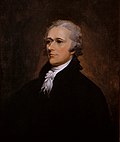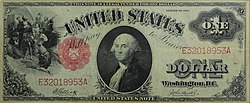United States dollar
The United States dollar (or American dollar) is the official currency (money) of the United States of America. It is also used in some other countries outside the US. It is the standard currency for international markets selling goods such as gold and oil (petrol). When writing, the symbol for the American dollar is the dollar sign ($). Dollars can also be known as USD (standing for 'U.S. dollar').
| United States dollar | |||
|---|---|---|---|
| |||
| ISO 4217 Code | USD | ||
| User(s) | See § Official users (19), § Unofficial users (8) | ||
| Inflation | 2.7% or 2.6% | ||
| Source | BLS (July 2025) or BEA (June 2025) | ||
| Method | CPI or PCE | ||
| Pegged by | See § Pegged currencies | ||
| Superunit | |||
| 10 | Eagle | ||
| 100 | Union (Proposed, never issued) | ||
| Subunit | |||
| 1⁄10 | Dime | ||
| 1⁄100 | Cent | ||
| 1⁄1000 | Mill | ||
| Symbol | $, US$, U$ | ||
| Cent | ¢ | ||
| Mill | ₥ | ||
| Nickname | List
| ||
| Coins | |||
| Freq. used | 1¢, 5¢, 10¢, 25¢ | ||
| Rarely used | 50¢, $1 (still minted); 1⁄2¢, 2¢, 3¢, 20¢, $2.50, $3, $5, $10, $20
(discontinued, but still legal tender); $25, $50, $100 (not intended for circulation) | ||
| Banknotes | |||
| Freq. used | $1, $5, $10, $20, $50, $100 | ||
| Rarely used | $2 (still printed); $500, $1,000, $5,000, $10,000 (discontinued, but still legal tender); $100,000 (discontinued, not legal tender, and only used for specific purposes) | ||
| Central bank | Federal Reserve | ||
| Website | [http://federalreserve.gov federalreserve.gov] | ||
| Printer | Bureau of Engraving and Printing | ||
| Website | [http://bep.gov bep.gov] | ||
| Mint | United States Mint | ||
| Website | [http://usmint.gov usmint.gov] | ||
Denominations and value
| Name | Worth | Face | discontinued? |
|---|---|---|---|
| Penny | 1C | Abraham Lincoln | no |
| Nickel | 5C | Thomas Jefferson | no |
| Dime | 10C | Franklin D. Roosevelt | no |
| Quarter | 25C | George Washington | no |
| Half Dollar | 50C | John F. Kennedy | yes |
| Dollar Coin | 1$ | Sacagawea | yes |
| 1$ Bill | 1$ | George Washington | no |
| 2$ Bill | 2$ | Thomas Jefferson | no |
| 5$ Bill | 5$ | Abraham Lincoln | no |
| 10$ Bill | 10$ | Alexander Hamilton | no |
| 20$ Bill | 20$ | Andrew Jackson | no |
| 50$ Bill | 50$ | Ulysses S. Grant | no |
| 100$ Bill | 100$ | Benjamin Franklin | no |
| 500$ Bill | 500$ | William McKinley | yes |
| 1000$ Bill | 1000$ | Grover Cleveland | yes |
| 5000$ Bill | 5000$ | James Madison | yes |
| 10000$ Bill | 10000$ | Salmon P. Chase | yes |
| 100000$ Bill | 100000$ | Woodrow Wilson | yes |
All U.S. dollar currency has been the same size, shape and general design since 1928. This is unlike some countries where bank notes with different values have different sizes.
The U.S. also has dollar coins. Some are silver colored and some are gold colored. Vending machines often give dollar coins as change, since it is easier for the machines to give out coins than paper money. Some of the more advanced vending machines give out paper money as change. Paper dollars are much more common than dollar coins.
The US dollar in subdivided into cents. 100 cents equals 1 US dollar. One cent can be written as either $0.01 or 1¢. The cent or "penny" (not to be confused with the English penny sterling) is the least worth coin used in the U.S.. There are several different coins with different cent values of different materials and sizes. There is the penny (1¢ or $0.01), nickel (5¢ or $0.05), dime (10¢ or $0.10), quarter (25¢ or $0.25), and the much rarer half-dollar (50¢ or $0.50).[1] All coins and paper bills have the faces of famous Americans on the front side.
Federal Reserve
The paper "dollar bill" is legally called a "Federal Reserve Note". Federal Reserve notes are legal tender currency notes. The twelve Federal Reserve Banks issue them into circulation under the Federal Reserve Act of 1913. A commercial bank belonging to the Federal Reserve System can obtain Federal Reserve notes from the Federal Reserve Bank in its district whenever it wishes by paying for them in full, dollar for dollar, from its account with Federal Reserve Bank.
Federal Reserve Banks get the notes from the U.S. Bureau of Engraving and Printing (BEP). It pays the BEP for the cost of producing the notes.
Congress has specified that a Federal Reserve Bank must hold collateral equal in value to the Federal Reserve notes that the Bank receives. This collateral is chiefly gold certificates and United States securities. This provides backing for the note issue.
Federal Reserve notes are not redeemable in gold, silver or any other commodity, and receive no backing by anything. This has been the case since 1933. The notes have no value for themselves, but for what they will buy.
The Coinage Act of 1965 titled "Legal tender" states: "United States coins and currency (including Federal reserve notes and circulating notes of Federal reserve banks and national banks) are legal tender for all debts, public charges, taxes, and dues".
This law means that all United States money as identified above are a valid and legal offer of payment for debts. There is no Federal statute saying a person or organization must accept currency or coins as payment for goods and/or services. Private businesses are free to develop their own policies on whether or not to accept cash. But there might be a State law which says otherwise. For example, a bus line may prohibit payment of fares in pennies or dollar bills. Businesses may refuse to accept large denomination currency (usually notes above $20) as a matter of policy.[2]
Meeting the variable demand for cash
People get cash from banks using automated teller machines (ATMs) or by cashing cheques. The amount of cash that the public holds varies seasonally, by the day of the month, and even by the day of the week. For example, people demand a large amount of cash for shopping and vacations during the year-end holiday season. Also, people typically withdraw cash at ATMs over the weekend, so there is more cash in circulation on Monday than on Friday.
To meet the demands of their customers, banks get cash from Federal Reserve Banks. Most medium- and large-sized banks have reserve accounts at one of the 12 regional Federal Reserve Banks, and they pay for the cash they get from them by having those accounts debited. Some smaller banks maintain their required reserves at larger, "correspondent," banks. The smaller banks get cash through the correspondent banks, which charge a fee for the service. The larger banks get currency from the Fed and pass it on to the smaller banks.
When the public's demand for cash declines—after the holiday season, for example—banks find they have more cash than they need and they deposit the excess at the Fed. Because banks pay the Fed for cash by having their reserve accounts debited, the level of reserves in the banking system drops when the public's demand for cash rises; similarly, the level rises again when the public's demand for cash subsides and banks ship cash back to the Fed.
The popularization of the ATM in recent years has increased the public's demand for currency and, in turn, the amount of currency that banks order from the Fed. Interestingly, the advent of the ATM has led some banks to request used, fit bills, rather than new bills, because the used bills often work better in the ATMs.
Maintaining a cash inventory
Each of the 12 Federal Reserve Banks keeps enough cash to meet the needs of the depository institutions in its District. Extended custodial inventory sites in several continents promote the use of U.S. currency internationally, improve the collection of information on currency flows, and help local banks meet the public's demand for U.S. currency. Additions to that supply come directly from the two divisions of the Treasury Department that produce the cash: the Bureau of Engraving and Printing, which prints currency, and the United States Mint, which makes coins. Most of the inventory consists of deposits by banks that had more cash than they needed to serve their customers and deposited the excess at the Fed to help meet their reserve requirements.
When a Federal Reserve Bank receives a cash deposit from a bank, it checks the individual notes to determine whether they are fit for future circulation. About one-third of the notes that the Fed receives are not fit, and the Fed destroys them. As shown in the table below, the life of a note varies according to its denomination. For example, a $1 bill, which gets the greatest use, remains in circulation an average of 5.9 years; a $100 bill lasts about 15 years.
Gallery
George Washington is on the front of the $1 bill
The Great Seal of the United States is on the back of the $1 Bill
Thomas Jefferson is on the front of the $2 bill
the back of the bill showing the signing of the Declaration of Independence
Abraham Lincoln is on the front of the $5 bill
The Lincoln Memorial is on the back of the $5 bill
Alexander Hamilton is on the front of the $10 bill
The U.S. Treasury Building is on the back of the $10 bill
Andrew Jackson is on the front of the $20 bill
The White House is on the back of the $20 bill
Ulysses S. Grant is on the front of the $50 bill
The U.S. Capitol is on the back of the $50 bill
Benjamin Franklin is on the front of the $100 bill
Independence Hall is on the back of the $100 bill
William McKinley was on the front of the $500 bill
Grover Cleveland was on the front of the $1,000 bill
James Madison was on the front of the $5,000 bill
Salmon P. Chase was on the front of the $10,000 bill
Woodrow Wilson was on the front of the $100,000 bill
United States Dollar Media
Spanish silver eight-real or peso of 1768
Alexander Hamilton finalized the details of the 1792 Coinage Act and the establishment of the U.S. Mint.
Series of 1917 $1 United States Note
Gold double eagle ($20 coin), 1907
John Maynard Keynes (right) and Harry Dexter White at the inaugural meeting of the International Monetary Fund in 1946. They were instrumental in drafting the provisions of the post-war global financial system.
Other websites
- Heiko Otto (ed.). "Banknotes of the United States" (in English and Deutsch). Retrieved 2017-03-10.
![]() Media related to United States dollar at Wikimedia Commons
Media related to United States dollar at Wikimedia Commons



































